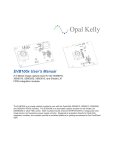Download XEM5010 User`s Manual
Transcript
Opal Kelly XEM5010 User’s Manual A compact (85mm x 61mm) integration board featuring the Xilinx Virtex-5 FPGA and on-board DDR2 SDRAM, SSRAM, and SPI Flash. The XEM5010 is a compact USB-based FPGA integration board featuring the Xilinx Virtex-5 FPGA, 256 MB 2x16-bit wide DDR2 SDRAM, 1Mx36 SyncSRAM, 32 Mb non-volatile flash, high-efficiency switching power supplies, and two high-density 0.8-mm expansion connectors. The USB 2.0 interface provides fast configuration downloads and FPGA-PC communication as well as easy access with our popular FrontPanel software and developer’s API. An on-board low-jitter, LVDS clock oscillator provides a 100 MHz clock source to the FPGA. Software, documentation, samples, and related materials are Copyright © 2006-2014 Opal Kelly Incorporated. Opal Kelly Incorporated Portland, Oregon http://www.opalkelly.com All rights reserved. Unauthorized duplication, in whole or part, of this document by any means except for brief excerpts in published reviews is prohibited without the express written permission of Opal Kelly Incorporated. Opal Kelly, the Opal Kelly Logo, and FrontPanel are trademarks of Opal Kelly Incorporated. Linux is a registered trademark of Linus Torvalds. Microsoft and Windows are both registered trademarks of Microsoft Corporation. All other trademarks referenced herein are the property of their respective owners and no trademark rights to the same are claimed. Revision History: Date Description 20090721 Initial release. 20090730 Corrected JP2 pins JP2-9, 10, 11, 12. 20090909 Fix typo on pinout page 23. (JP2 relabeled to JP3) 20091105 Updated documentation to include VDC input voltage range and proper location of +3.3v and +1.0v outputs on JP2/JP3. 20091227 Added BRK5010 schematic and mechanical drawing. 20100226 Added BRK5010 errata. 20101101 Added example heatsink part number. 20101104 Added note about on-board termination for the LVDS oscillator. 20110926 Fixed SSRAM pin list. 20140331 Added remark about the Pins reference. 20140812 Fixed typo in I/O voltages section. Can set voltage on six banks (not four). Contents Introducing the XEM5010 . . . . . . . . . . . . . . . . . . . . . . . 5 PCB Footprint. . . . . . . . . . . . . . . . . . . . . . . . . . . . . . . . . . . . . 5 Functional Block Diagram. . . . . . . . . . . . . . . . . . . . . . . . . . . . 6 Power Supply. . . . . . . . . . . . . . . . . . . . . . . . . . . . . . . . . . . . . 6 Supply Heat Dissipation (IMPORTANT!!). . . . . . . . . . . . . 6 DC Power Connector. . . . . . . . . . . . . . . . . . . . . . . . . . . . 6 VBATT . . . . . . . . . . . . . . . . . . . . . . . . . . . . . . . . . . . . . . . 7 Supply Currents. . . . . . . . . . . . . . . . . . . . . . . . . . . . . . . . 7 USB Bus Power. . . . . . . . . . . . . . . . . . . . . . . . . . . . . . . . 7 USB 2.0 Interface. . . . . . . . . . . . . . . . . . . . . . . . . . . . . . . . . . 7 On-board Peripherals. . . . . . . . . . . . . . . . . . . . . . . . . . . . . . . 7 Clock Oscillator . . . . . . . . . . . . . . . . . . . . . . . . . . . . . . . . 7 Serial EEPROM. . . . . . . . . . . . . . . . . . . . . . . . . . . . . . . . 7 256-MByte Synchronous DDR2 DRAM (2x 128-MByte). 8 36-Mb Word-Wide Synchronous SRAM . . . . . . . . . . . . . 8 32-Mb SPI Serial Flash . . . . . . . . . . . . . . . . . . . . . . . . . . 8 LEDs and External LED Connections . . . . . . . . . . . . . . . 8 Expansion Connectors. . . . . . . . . . . . . . . . . . . . . . . . . . . . . . 8 FrontPanel Support. . . . . . . . . . . . . . . . . . . . . . . . . . . . . . . . . 8 Programmer’s Interface. . . . . . . . . . . . . . . . . . . . . . . . . . 8 Applying the XEM5010 . . . . . . . . . . . . . . . . . . . . . . . . . 11 Host Interface. . . . . . . . . . . . . . . . . . . . . . . . . . . . . . . . . . . . . 11 MUXSEL. . . . . . . . . . . . . . . . . . . . . . . . . . . . . . . . . . . . . . 12 LEDs. . . . . . . . . . . . . . . . . . . . . . . . . . . . . . . . . . . . . . . . . . . . 12 Clock Oscillator Connections. . . . . . . . . . . . . . . . . . . . . . . . . 13 JTAG. . . . . . . . . . . . . . . . . . . . . . . . . . . . . . . . . . . . . . . . . . . . 13 SPI Flash Connections. . . . . . . . . . . . . . . . . . . . . . . . . . . . . . 13 FPGA Configuration via SPI Flash . . . . . . . . . . . . . . . . . 13 DDR2 SDRAM. . . . . . . . . . . . . . . . . . . . . . . . . . . . . . . . . . . . 13 FPGA Connections. . . . . . . . . . . . . . . . . . . . . . . . . . . . . . 13 Cascaded DCI . . . . . . . . . . . . . . . . . . . . . . . . . . . . . . . . . 15 Memory Interface Generator (MIG). . . . . . . . . . . . . . . . . 15 MIG Settings. . . . . . . . . . . . . . . . . . . . . . . . . . . . . . . . . . . 16 MIG Pin Selection. . . . . . . . . . . . . . . . . . . . . . . . . . . . . . . 16 Synchronous SRAM. . . . . . . . . . . . . . . . . . . . . . . . . . . . . . . . 16 High-Performance Operation. . . . . . . . . . . . . . . . . . . . . . 16 SSRAM / FPGA Connections . . . . . . . . . . . . . . . . . . . . . 17 Expansion Connectors. . . . . . . . . . . . . . . . . . . . . . . . . . . . . . 18 IMPORTANT NOTE: 3.3v I/O Operation. . . . . . . . . . . . . 18 JP2. . . . . . . . . . . . . . . . . . . . . . . . . . . . . . . . . . . . . . . . . . 18 JP3. . . . . . . . . . . . . . . . . . . . . . . . . . . . . . . . . . . . . . . . . . 18 Setting I/O Voltages. . . . . . . . . . . . . . . . . . . . . . . . . . . . . 18 Considerations for Differential Signals. . . . . . . . . . . . . . . 19 BRK5010 Breakout Board. . . . . . . . . . . . . . . . . . . . . . . . . . . . 19 Errata: Datecode 20091013. . . . . . . . . . . . . . . . . . . . . . . 20 Errata: Datecode 20091013 and 20091209. . . . . . . . . . . 20 XEM5010 User’s Manual XEM5010 Mechanical Drawing. . . . . . . . . . . . . . . . . . . 22 BRK5010 Mechanical Drawing . . . . . . . . . . . . . . . . . . . 23 BRK5010 Schematic (20100226). . . . . . . . . . . . . . . . . . 24 XEM5010 Quick Reference. . . . . . . . . . . . . . . . . . . . . . 25 XEM5010 Quick Reference. . . . . . . . . . . . . . . . . . . . . . 26 XEM5010 Quick Reference. . . . . . . . . . . . . . . . . . . . . . 27 XEM5010 Quick Reference. . . . . . . . . . . . . . . . . . . . . . 28 4 www.opalkelly.com XEM3050 User’s Manual Introducing the XEM5010 The XEM5010 is a compact (85mm x 61mm, 3.35” x 2.40”) FPGA board featuring the Xilinx Virtex-5 FPGA. Designed as a full-featured integration system, the XEM5010 provides access to 200 I/O pins on its 676-pin Virtex-5 device and has 256-MByte of DDR2 SDRAM, 36-Mb of SSRAM, and 4-MByte of Flash memory available to the FPGA. PCB Footprint A mechanical drawing of the XEM5010 is shown at the end of this manual. The PCB is 85mm x 61mm with four mounting holes spaced as shown in the figure. These mounting holes are electrically isolated from all signals on the XEM5010. The two connectors (USB and DC power) overhang the PCB by approximately 4mm in order to accomodate mounting within an enclosure. The XEM5010 has two high-density 120-pin connectors on the bottom side which provide access to many FPGA pins, power, JTAG, and the microcontroller’s I2C interface. www.opalkelly.com 5 XEM5010 User’s Manual Functional Block Diagram 100 MHz LVDS OSC USB USB Micro (CY68013A) Host Interface Bus 2x DDR2-667 (64Mx16) Virtex-5 FPGA (XC5VLX50-1FGG676) 100 I/O JTAG 80 I/O 20 GCLK SSRAM (1Mx36) Flash (32Mb) 4 LEDs XBUS (JP2) YBUS (JP3) Power Supply The XEM5010 has four high-efficiency switching regulators to provide clean, well-regulated power to the FPGA and peripherals on the board. These are Enpirion power modules and configured to supply 3.3v, 2.5v, 1.8v, and 1.0v. P1 is the DC power connector on the board and sources +VDC to all four regulators. Alternatively, +VDC can be provided through the expansion connector (JP3). +VDC must be sourced from a well-regulated power supply in the range of +4.5v to +5.5v. Supply Heat Dissipation (IMPORTANT!!) Due to the limited area available on the small form-factor of the XEM5010 and the density of logic provided, heat dissipation should be a concern. This depends entirely on the end application and cannot be predicted in advance by Opal Kelly. Heat sinks may be required on any of the devices on the XEM5010. Of primary focus should be the FPGA (U12). Although the switching supplies are high-efficiency, they are very compact and consume a small amount of PCB area for the current they can provide. The FPGA will require additional passive or active cooling for even simple designs. One such passive heatsink would be the INM27002-12PCU/2.6 available from Radian (www.radianheatinks.com). The blue clip version (BU+T710) fits the Virtex-5 on the XEM5010. Of course, this specific heatsink may not be suitable for all designs. DC Power Connector The DC power connector on the XEM5010 is part number PJ-102AH from CUI, Inc. It is a standard 2.1mm / 5.5mm power jack. The outer ring is attached to DGND. The center pin is attached to +VDC on expansion connector JP3 as well as the inputs to the switching regulators on the XEM5010. 6 www.opalkelly.com XEM5010 User’s Manual VBATT +VBATT is connected to the JP3 expansion connector and can be powered by a daughterboard to the FPGA. This voltage is used to maintain a small memory on the FPGA to support bitstream encryption. Please see the Xilinx Virtex-5 documentation for details. Supply Currents The on-board regulators provide the following supplies and respective current: • • • • +3.3v @ 1.0A - USB microcontroller, clock oscillator, and default FPGA I/O. +2.5v @ 2.0A - FPGA VCCAUX +1.8v @ 1.0A - DDR2 SDRAM and SSRAM +1.0v @ 6.0A - FPGA VCCINT +3.3v is available on JP2 and +1.0v is available on JP3. Designers should note the current limitations before deciding to use these supplies. USB Bus Power The USB 2.0 specification allows for up to 2.5 W (500mA at 5v) to be provided to external peripherals over the USB cable. Due to the potentially high power requirements of the XEM5010, USB power has not been connected. However, the XEM firmware reports to the USB hub as a 500-mA device. USB 2.0 Interface The XEM5010 uses a Cypress CY7C68013A FX2LP USB microcontroller to make the XEM a USB 2.0 peripheral. As a USB peripheral, the XEM is instantly recognized as a plug and play peripheral on millions of PCs. More importantly, FPGA downloads to the XEM happen blazingly fast, virtual instruments under FrontPanel update quickly, and data transfers are much faster than the parallel port interfaces common on many FPGA experimentation boards. On-board Peripherals The XEM5010 is designed to compactly support a large number of applications with a small number of on-board peripherals. These peripherals are listed below. Clock Oscillator The clock oscillator produces a 100 MHz (±50ppm) LVDS signal with 45/55% symmetry and 0.5ps typical phase jitter (1.0-ps RMS max) measured from 12 kHz - 80 MHz. Serial EEPROM A small serial EEPROM is attached to the USB microcontroller on the XEM5010, but not directly available to the FPGA. The EEPROM is used to store boot code for the microcontroller as well as a device identifier string. The device identifier string may be changed at any time using FrontPanel. The string serves only a cosmetic purpose and is used when multiple XEM devices are attached to the same computer so you may select the proper active device. www.opalkelly.com 7 XEM5010 User’s Manual 256-MByte Synchronous DDR2 DRAM (2x 128-MByte) The XEM also includes two 128-MByte DDR2 SDRAM with fully independent 16-bit word-wide interfaces to the FPGA. This SDRAMs are attached exclusively to the FPGA and do not share any pins with the expansion connector. The maximum clock rate of the SDRAM is 266 MHz. None of the pins (control, address, or data) are shared between the two SDRAM busses. The SDRAM is a Micron MT47H64M16HR-3:G (or compatible). 36-Mb Word-Wide Synchronous SRAM One synchronous SRAM (1M x 36 configuration) is included with dedicated address, data, and control lines routed to the FPGA. The SSRAM is a GSI Technology GS8322Z36GB-200V (or equivalent). 32-Mb SPI Serial Flash One Numonyx M25P32 (or equivalent) SPI serial flash is connected to the FPGA for non-volatile storage. LEDs and External LED Connections Four on-board LEDs are provided for general use. In addition, a 5-pin expansion connector (JP4) allows the connection of a external LEDs. Four pins of this connector are wired to FPGA pins via series 330-Ω resistors. Expansion Connectors Two high-density, 120-pin expansion connectors are available on the bottom-side of the XEM5010 PCB. These expansion connectors provide user access to several power rails on the XEM5010, several FPGA clock inputs, the JTAG chain, and 200 non-shared I/O pins on the FPGA. The connectors on the XEM5010 are Samtec part number: QSE-060-01-F-D-A. The table below lists the appropriate Samtec mating connectors along with the total mated height. Samtec Part Number Mated Height QTE-060-01-F-D-A 5.00mm (0.198”) QTE-060-02-F-D-A 8.00mm (0.316”) FrontPanel Support The XEM5010 is fully supported by Opal Kelly’s FrontPanel software. FrontPanel augments the limited peripheral support with a host of PC-based virtual instruments such as LEDs, hex displays, pushbuttons, toggle buttons, and so on. Essentially, this makes your PC a reconfigurable I/O board and adds enormous value to the XEM5010 as an experimentation or prototyping system. Programmer’s Interface In addition to complete support within FrontPanel, the XEM5010 is also fully supported by the FrontPanel programmer’s interface (API), a powerful C++ class library available to Windows and Linux programmers allowing you to easily interface your own software to the XEM. 8 www.opalkelly.com XEM5010 User’s Manual In addition to the C++ library, wrappers have been written for C#, Java, Python, and Ruby making the API available under those languages as well. Sample wrappers are also provided for Matlab and LabVIEW. Complete documentation and several sample programs are installed with FrontPanel. www.opalkelly.com 9 XEM5010 User’s Manual 10 www.opalkelly.com XEM3050 User’s Manual Applying the XEM5010 Host Interface There are 26 pins that connect the on-board USB microcontroller to the FPGA. These pins comprise the host interface on the FPGA and are used for configuration downloads. After configuration, these pins are used to allow FrontPanel communication with the FPGA. If the FrontPanel okHost module is instantiated in your design, you must map the interface pins to specific pin locations using Xilinx LOC constraints. This may be done using the Xilinx constraints editor or specifying the constraints manually in a text file. An example is shown below: Xilinx constraints for okHost pin mappings: www.opalkelly.com 11 XEM5010 User’s Manual NET NET NET NET NET NET NET NET NET NET NET NET NET NET NET NET NET NET NET NET NET NET NET NET NET NET NET “hi_in<0>” “hi_in<1>” “hi_in<2>” “hi_in<3>” “hi_in<4>” “hi_in<5>” “hi_in<6>” “hi_in<7>” “hi_out<0>” “hi_out<1>” “hi_inout<0>” “hi_inout<1>” “hi_inout<2>” “hi_inout<3>” “hi_inout<4>” “hi_inout<5>” “hi_inout<6>” “hi_inout<7>” “hi_inout<8>” “hi_inout<9>” “hi_inout<10>” “hi_inout<11>” “hi_inout<12>” “hi_inout<13>” “hi_inout<14>” “hi_inout<15>” “hi_muxsel” LOC=”AD13” LOC=”AD15” LOC=”AD14” LOC=”AB12” LOC=”Y8” LOC=”AA8” LOC=”AA17” LOC=”AB17” LOC=”AC14” LOC=”AC11” LOC=”AD18” LOC=”AC18” LOC=”AB10” LOC=”AB9” LOC=”AC17” LOC=”AC16” LOC=”AC8” LOC=”AC9” LOC=”Y12” LOC=”Y13” LOC=”AA15” LOC=”AB14” LOC=”AA12” LOC=”AB11” LOC=”AA13” LOC=”AA14” LOC=”AB15” | | | | | | | | | | | | | | | | | | | | | | | | | | | IOSTANDARD=”LVCMOS33”; IOSTANDARD=”LVCMOS33”; IOSTANDARD=”LVCMOS33”; IOSTANDARD=”LVCMOS33”; IOSTANDARD=”LVCMOS33”; IOSTANDARD=”LVCMOS33”; IOSTANDARD=”LVCMOS33”; IOSTANDARD=”LVCMOS33”; IOSTANDARD=”LVCMOS33”; IOSTANDARD=”LVCMOS33”; IOSTANDARD=”LVCMOS33”; IOSTANDARD=”LVCMOS33”; IOSTANDARD=”LVCMOS33”; IOSTANDARD=”LVCMOS33”; IOSTANDARD=”LVCMOS33”; IOSTANDARD=”LVCMOS33”; IOSTANDARD=”LVCMOS33”; IOSTANDARD=”LVCMOS33”; IOSTANDARD=”LVCMOS33”; IOSTANDARD=”LVCMOS33”; IOSTANDARD=”LVCMOS33”; IOSTANDARD=”LVCMOS33”; IOSTANDARD=”LVCMOS33”; IOSTANDARD=”LVCMOS33”; IOSTANDARD=”LVCMOS33”; IOSTANDARD=”LVCMOS33”; IOSTANDARD=”LVCMOS33”; Each of the samples installed with FrontPanel includes a copy of a template constraints file that lists all the XEM5010 pins and maps them to the appropriate FPGA pins using LOC (location) constraints. You can use this template to quickly get the pin locations correct on a new design. MUXSEL MUXSEL is a signal on the XEM5010 which selects the signal path to the FPGA programming signals D0 and CCLK. When low (deasserted), the FPGA and USB microcontroller are connected. When high (asserted), the FPGA and PROM are connected. In normal USB-programmed operation, J1 pulls MUXSEL low, connecting the FPGA and USB microcontroller at all times. This allows USB-based programming of the FPGA and subsequent USB communication with the FPGA design after configuration. In order to allow the PROM to configure the FPGA, J1 must be removed. However, if the USB is to communicate with the FPGA post-configuration, MUXSEL must be deasserted. Therefore, the FPGA outputs MUXSEL so that, post-configuration, the FPGA can deassert MUXSEL and communicate over USB even after the PROM has configured it. The end result is that your FPGA design should tie HI_MUXSEL to 0. For example, in Verilog: assign hi_muxsel = 1’b0; LEDs There are four LEDs and four external LED pins on the XEM5010. Each is wired directly to the FPGA according to the pin mapping tables at the end of this document. 12 www.opalkelly.com XEM5010 User’s Manual The LED anodes are connected to a pull-up resistor to +3.3VDD and the cathodes wired directly to the FPGA. To turn ON an LED, the FPGA pin should be brought low. To turn OFF an LED, the FPGA pin should be brought high. The external LED connector is wired a bit differently. JP4-1 is attached to +3.3VDD. JP4-2 through JP4-5 are each attached through a 330-Ω resistor to an FPGA pin. Externally, you should connect the four LED anodes to JP4-1 (+3.3VDD). The four cathode should be attached to the other pins on JP4. Clock Oscillator Connections The LVDS clock oscillator produces a 100 MHz LVDS signal which is presented on FPGA pins AD8 and AC7. These are L4P_GC_4 and L4N_GC4 inputs, respectively. An on-board 100-ohm termination resistor is present. JTAG On the XEM5010, the FPGA is the only device on the JTAG chain. The JTAG pins connecting to the FPGA are available on the expansion connector JP2 so that you can attach a suitable JTAG chain or programmer on your boart. SPI Flash Connections The on-board SPI flash device is attached to the FPGA according to the following table. Flash Pin Signal CLK AA18 CS AA10 DOUT Y18 DIN AA9 FPGA Configuration via SPI Flash The Virtex-5 on the XEM5010 may be configured by USB or SPI Flash. When using USB, the FPGA may be configured at any time. When booting by SPI Flash, configuration takes place at power-on. To boot to the configuration file loaded into the SPI Flash, remove the jumper at J1. To load the SPI Flash with your configuration data, we have provided a sample (FlashLoader) which is located in the Samples directory of your installation. This is a simple command-line utility that can be used to transfer a configuration bitfile to SPI Flash. The source code to the software is included so you can include this utility in your own application, if required. DDR2 SDRAM FPGA Connections The DDR2 SDRAMs are connected exclusively to the 1.8v I/O on Banks 11, 12, 15, and 16 of the FPGA. The tables below list these connections. DDR2A is U15 on the PCB. DDR2B is U14. www.opalkelly.com 13 XEM5010 User’s Manual DDR2A Pin FPGA Pin DDR2A Pin FPGA Pin CK D5 A9 B4 CK D6 A10 C4 CKE H6 A11 C7 CS F4 A12 C6 RAS G6 BA0 E5 CAS G7 BA1 E6 WE F5 BA2 F7 LDQS D8 D0 D11 LDQS C8 D1 D10 UDQS B7 D2 C11 UDQS A7 D3 C12 LDM C13 D4 B12 UDM A9 D5 A13 ODT J6 D6 A12 A0 E7 D7 C9 A1 B2 D8 B9 A2 B1 D9 B10 A3 C1 D10 B11 A4 D1 D11 A10 A5 A3 D12 A8 A6 A2 D13 B5 A7 C3 D14 B6 C2 D15 D3 A8 14 www.opalkelly.com XEM5010 User’s Manual DDR2B Pin FPGA Pin DDR2B Pin FPGA Pin CK D21 A9 C23 CK D20 A10 B24 CKE H21 A11 B21 CS F23 A12 C21 RAS E22 BA0 E20 CAS E23 BA1 E21 WE F22 BA2 F20 LDQS A20 D0 C14 LDQS B20 D1 B14 UDQS C19 D2 A14 UDQS D19 D3 A15 LDM B15 D4 B16 UDM B19 D5 D16 ODT G21 D6 C16 A0 G20 D7 D18 A1 D25 D8 B17 A2 D26 D9 A17 A3 C26 D10 A18 A4 B26 D11 A19 A5 A25 D12 C18 A6 B25 D13 B22 A7 C24 D14 A22 D24 D15 A23 A8 Cascaded DCI The FPGA interface to the DDR2 SDRAM utilizes the digitally-controlled impedance (DCI) feature of the Virtex-5. VRN and VRP pads on banks 15 and 16 are attached through 1% 49.9Ω resistors to +1.8VDD and DGND, respectively. Banks 11 and 12 use references that are “cascaded” from banks 15 and 16. Cascade configuration must be specified in your constraints file (.UCF). For example: CONFIG DCI_CASCADE = “16 12”; CONFIG DCI_CASCADE = “15 11”; Memory Interface Generator (MIG) MIG is part of the Xilinx Core Generator and can be used to create a DDR2 memory controller for the XEM5010. You should read and become familiar with the DDR2 SDRAM datasheet as well as MIG and the core datasheet. Although MIG can save a tremendous amount of development time, understanding all this information is critical to building a working DDR2 memory interface. www.opalkelly.com 15 XEM5010 User’s Manual MIG Settings The following are the settings used to generate the MIG core for our RAMTester sample using Xilinx Core Generator. These settings were used with ISE 10.2 and MIG 2.3. Note that settings may be slightly different for different versions of ISE or MIG. Frequency 266 MHz Memory Type Component Memory Part MT47H64M16XX-3 (1Gb, x16) Data Width16 Data Mask Checked Burst Length 4(010) Burst Type Sequential(0) CAS Latency 4(100) Output drive strength Reducedstrength(1) RTT(nominal) 75ohms(01) Additive latency(AL) 0(000) Use DCM Your option DCI for DQ/DQS CHECKED DCI for address/control CHECKED Class for address/control Class II Debug signals Your option Limit to 2 bytes per bank No System clockDifferential [default] [default] [default] [default] [default] MIG Pin Selection To help MIG select the proper pins for the constraints (UCF), you can direct it to reserve nonDDR2 banks and tell it where to map controllers for the others. The selection process is: ● Reserve banks 1, 2, 3, 13, 14, 17, 18, 21. MIG will not use these. ● For controller C0, check all in banks 4, 12, 16. Uncheck all others. ● For controller C1, check all in banks 4, 11, 15. Uncheck all others. Synchronous SRAM The SSRAM has a full 36-bit wide data bus (4 bytes + 4 parity pits). The CLK pin is attached directly to the FPGA with the intent that the FPGA provide a synchronous clock in the so-called “source synchronous” manner. This helps align clock and data between the FPGA and SSRAM. The redundant chip enable pins of the SSRAM have been tied to enable, as appropriate. E2 is tied to +1.8VDD and E3 is tied to DGND. ZQ has been left as a no-connect. LBO is tied to DGND, enabling linear byte order operation. Finally, all four byte enables (BA, BB, BC, and BD) are tied to DGND. High-Performance Operation The SSRAM can achieve operation to 200 MHz, but requires careful consideration of all FPGA timing parameters. We provide the following as suggestions based on our development of test code, but recommend a thorough timing analysis to achieve high-performance, reliable operation. A good understanding of the SSRAM and FPGA timing datasheets is critical to this analysis. 16 www.opalkelly.com XEM5010 User’s Manual The SSRAM has a 0.5-ns hold time. By setting the SSRAM_CLK output from the FPGA to “FAST”, this can advance the timing of the CLK in comparison to the address/control lines. According to the FPGA timings (TIOOP), this achieves approximately 0.6-ns hold time. Delays from FPGA pads to the internal fabric can be significant and cause problems at high clock rates. You must consider all delays when determining timing. The following illustrates the timings considered for SSRAM reads. Note that parts will differ depending on manufacturing process corners and operating techniques. Adaptive techniques using the IDELAY elements help achieve optimal results. TOCKQ OLOGIC CLK-to-OQ 0.62 ns TIOOP Delay from O pin to the IOB pad for CLOCK output 1.93 ns TKQ SSRAM clock to Q (read timing) 5.00 ns TIOPI Delay from IOB pad to the I pin of the IOB 0.89 ns TIDOCK ILOGIC D pin setup with respect to CLK without delay 0.39 ns Total 8.83 ns This table indicates that for clock frequencies exceeding approximately 113 MHz, SSRAM data reads may not be available to the FPGA fabric until the next clock cycle. Therefore, there is a single-cycle read delay inherent in the design routing that must be accounted for in your design. SSRAM / FPGA Connections SSRAM Pin FPGA Pin SSRAM Pin FPGA Pin SSRAM Pin FPGA Pin CLK R22 A14 R23 D14 N22 CKE L4 A15 J23 D15 L22 WE J21 A16 N23 DP2 L19 CE1 M22 A17 L23 D16 H9 OE K22 A18 K23 D17 G11 ADV/LD J5 A19 H23 D18 G10 ZZ K5 A20 P23 D19 H11 FT M6 D0 R7 D20 G12 A0 L5 D1 R5 D21 H12 A1 M5 D2 P4 D22 F13 A2 M4 D3 R6 D23 H13 A3 L3 D4 P6 DP3 G9 A4 J4 D5 N6 D24 G14 A5 H4 D6 P5 D25 H14 A6 G4 D7 M7 D26 G15 A7 P3 DP1 N7 D27 F15 A8 N4 D8 M19 D28 H17 A9 T3 D9 L20 D29 G17 A10 R3 D10 M21 D30 G16 A11 H19 D11 P20 D31 G19 A12 K20 D12 N21 DP4 H18 A13 P19 D13 P21 www.opalkelly.com 17 XEM5010 User’s Manual Expansion Connectors Opal Kelly Pins is an interactive online reference for the expansion connectors on all Opal Kelly FPGA integration modules. It provides additional information on pin capabilities, pin characteristics, and PCB routing. Additionally, Pins provides a tool for generating constraint files for place and route tools. Pins can be found at the URL below. http://www.opalkelly.com/pins IMPORTANT NOTE: 3.3v I/O Operation As process technology shrinks, I/O voltages tend lower. The Xilinx Virtex-5 FPGA is no exception and has limited 3.3v I/O operation. Before using the XEM5010 to interface to any 3.3v design, please review the Xilinx Virtex-5 FPGA User Guide, Chapter 6: 3.3V I/O Design Guidelines. JP2 JP2 is a 120-pin high-density connector providing access to FPGA Banks 13, 17, and 21. Pin mappings for JP2 are listed at the end of this document in the “Quick Reference” section. For each JP2 pin, the corresponding board connection is listed. For pins connected to the FPGA, the corresponding FPGA pin number is also shown. Finally, for pins routed to differential pair I/ Os on the FPGA, the FPGA signal names and routed track lengths have been provided to help you equalize lengths on differential pairs. JP3 JP3 is a 120-pin high-density connector providing access to FPGA Banks 14, 18, and 3. Bank 3 is primarily a clock-input bank providing up to 10 differential clock inputs or 20 single-ended inputs. Pin mappings for JP3 are listed at the end of this document in the “Quick Reference” section. For each JP3 pin, the corresponding board connection is listed. For pins connected to the FPGA, the corresponding FPGA pin number is also shown. Finally, for pins routed to differential pair I/ Os on the FPGA, the FPGA signal names and routed track lengths have been provided to help you equalize lengths on differential pairs. Setting I/O Voltages The Virtex-5 FPGA allows users to set I/O bank voltages in order to support several different I/O signalling standards. This functionality is supported by the XEM5010 by allowing the user to connect independent supplies to the FPGA VCCO pins on six of the FPGA banks. By default, ferrite beads have been installed which attach each VCCO bank to the +3.3VDD supply. If you intend to supply power to a particular I/O bank, you MUST remove the appropriate ferrite beads. Power can then be supplied through the expansion connectors. The table below lists details for user-supplied I/O bank voltages. 18 I/O Bank Expansion Pin FPGA Pins Ferrite Bead 3 JP3-2, JP3-4 E14, D17 FB5 www.opalkelly.com XEM5010 User’s Manual I/O Bank Expansion Pin FPGA Pins Ferrite Bead 13 JP2-1, JP2-3 N20, M23, R24 FB1 14 JP3-41, JP3-43 W2, R4, V5 FB2 17 JP2-42, JP2-44 T21, W22, V25 FB3 18 JP3-85, JP3-87 AB3, AA6, AD7 FB4 21 JP2-86, JP2-88 AC20, AB23, AE24 FB6 Considerations for Differential Signals The XEM5010 PCB layout and routing has been designed with several applications in mind, including applications requiring the use of differential (LVDS) pairs. Please refer to the Xilinx Virtex-5 datasheet for details on using differential I/O standards with the Virtex-5 FPGA. FPGA I/O Bank Voltages In order to use differential I/O standards with the Virtex-5, you must set the VCCO voltages for the appropriate banks to 2.5v according to the Xilinx Virtex-5 datasheet. Please see the section above entitled “Setting I/O Voltages” for details. Characteristic Impedance The characteristic impedance of all routes from the FPGA to the expansion connector is 50-Ω. Differential Pair Lengths In many cases, it is desirable that the route lengths of a differential pair be matched within some specification. Care has been taken to route differential pairs on the FPGA to adjacent pins on the expansion connectors whenever possible. We have also included the lengths of the board routes for these connections to help you equalize lengths in your final application. Due to space constraints, some pairs are better matched than others. Digitally Controlled Impedance (DCI) The Xilinx Virtex-5 supports digitally controlled impedance. This functionality is supported when precision resistors are connected externally between the FPGA VRN/VRP lines and +VCCO/ DGND, respectively. These FPGA pins have been routed to the expansion connectors so that you may add resistors, as appropriate, on your daughterboard. BRK5010 Breakout Board The BRK5010 is a simple breakout board for the XEM5010 that conducts the high-density JP2 and JP3 signals to 2-mm headers for probing and simple prototyping. The board also serves as a reference design for boards to attach to the module. The mechanical drawing for this board is shown at the end of this document. JP1 on the BRK5010 is a JTAG header compatible with the 2-mm Xilinx JTAG programming cables. JP2A/B/C are directly attached to the mating JP2 connector on the XEM5010. JP3A/ B/C are directly attached to the mating JP3 connector on the XEM5010. The connections are straightforward: Pin 1 of JP2 (JP2-1) connects to JP2A-1. JP2-2 connects to JP2A-2. JP2-120 connects to JP2A-120. www.opalkelly.com 19 XEM5010 User’s Manual Errata: Datecode 20091013 BRK5010 boards with PCB datecode 20091013 have the XEM5010 mounting holes incorrectly inset by 0.5mm. The Samtec connectors (JP2 and JP3) are correctly placed. This error is corrected with PCB datecode 20091209 as shown in the mechanical drawing. Errata: Datecode 20091013 and 20091209 BRK5010 boards with PCB datecode 20091013 and 20091209 have incorrect routing as follows. Two pins were mis-routed, causing subsequent pins to be disjoint. 20 JP2 Samtec 2mm Pin Connection JP2-86 JP2-86 JP2-88 JP2-88 JP2-90 NOT CONNECTED JP2-92 NOT CONNECTED JP2-94 JP2C-90 JP2-96 JP2C-92 JP2-98 JP2C-94 JP2-100 JP2C-96 JP2-102 JP2C-98 JP2-104 JP2C-100 JP2-106 JP2C-102 JP2-108 JP2C-104 www.opalkelly.com XEM5010 User’s Manual www.opalkelly.com 21 XEM5010 User’s Manual 77.564 17.432 0 XEM5010 Mechanical Drawing 61 58 57.987 29.713 15.925 8.304 3 0 74.764 82 85 14.632 3.988 3 0 0 12 9 55.363 14.327 9.827 9.017 3.302 0 44.701 47.501 0 4X 5.680 0 0 2.5 All dimensions in mm. 22 www.opalkelly.com XEM5010 User’s Manual BRK5010 Mechanical Drawing All dimensions in mm. 135 132 131 106 100.74 97.94 87 43 42.26 39.46 27 www.opalkelly.com 89 97 100 76.89 77.50 22.50 27.21 0 3 8 3 0 23 www.opalkelly.com D C B 1 +3.3VDD +3.3VDD +VCCO13 +VCCO13 JP2_81 JP2_83 JP2_85 JP2_87 JP2_89 JP2_91 JP2_93 JP2_95 JP2_97 JP2_99 JP2_101 JP2_103 JP2_41 JP2_43 JP2_45 JP2_47 JP2_49 JP2_51 JP2_53 JP2_55 JP2_57 JP2_59 JP2_61 JP2_63 JP2_65 JP2_67 JP2_69 JP2_71 JP2_73 JP2_75 JP2_77 JP2_79 JP2_5 JP2_7 JP2_9 JP2_11 JP2_13 JP2_15 JP2_17 JP2_19 JP2_21 JP2_23 JP2_25 JP2_27 JP2_29 JP2_31 JP2_33 JP2_35 JP2_37 JP2_39 2 4 6 8 10 12 14 16 18 20 22 24 26 28 30 32 34 36 38 40 2 4 6 8 10 12 14 16 18 20 22 24 26 28 30 32 34 36 38 40 1 3 5 7 9 11 13 15 17 19 21 23 25 27 29 31 33 35 37 39 2 4 6 8 10 12 14 16 18 20 22 24 26 28 30 32 34 36 38 40 JP2C Header 20X2 1 3 5 7 9 11 13 15 17 19 21 23 25 27 29 31 33 35 37 39 JP2B Header 20X2 1 3 5 7 9 11 13 15 17 19 21 23 25 27 29 31 33 35 37 39 JP2A Header 20X2 JP2_86 JP2_88 JP2_90 JP2_92 JP2_94 JP2_96 JP2_98 JP2_100 JP2_102 JP2_104 JP2_82 JP2_84 JP2_46 JP2_48 JP2_50 JP2_52 JP2_54 JP2_56 JP2_58 JP2_60 JP2_62 JP2_64 JP2_66 JP2_68 JP2_70 JP2_72 JP2_74 JP2_76 JP2_78 JP2_80 JP2_2 JP2_4 JP2_6 JP2_8 JP2_10 JP2_12 JP2_14 JP2_16 JP2_18 JP2_20 JP2_22 JP2_24 JP2_26 JP2_28 JP2_30 JP2_32 JP2_34 JP2_36 JP2_38 JP2_40 +VCCO21 +VCCO21 +VCCO17 +VCCO17 2 2 +3.3VDD +3.3VDD +VCCO13 +VCCO13 JTAG_TDI JTAG_TDO JP2_81 JP2_83 JP2_85 JP2_87 JP2_89 JP2_91 JP2_93 JP2_95 JP2_97 JP2_99 JP2_101 JP2_103 JP2_41 JP2_43 JP2_45 JP2_47 JP2_49 JP2_51 JP2_53 JP2_55 JP2_57 JP2_59 JP2_61 JP2_63 JP2_65 JP2_67 JP2_69 JP2_71 JP2_73 JP2_75 JP2_77 JP2_79 JP2_5 JP2_7 JP2_9 JP2_11 JP2_13 JP2_15 JP2_17 JP2_19 JP2_21 JP2_23 JP2_25 JP2_27 JP2_29 JP2_31 JP2_33 JP2_35 JP2_37 JP2_39 81 83 85 87 89 91 93 95 97 99 101 103 105 107 109 111 113 115 117 119 41 43 45 47 49 51 53 55 57 59 61 63 65 67 69 71 73 75 77 79 1 3 5 7 9 11 13 15 17 19 21 23 25 27 29 31 33 35 37 39 DGND 82 84 86 88 90 92 94 96 98 100 102 104 106 108 110 112 114 116 118 120 42 44 46 48 50 52 54 56 58 60 62 64 66 68 70 72 74 76 78 80 2 4 6 8 10 12 14 16 18 20 22 24 26 28 30 32 34 36 38 40 JP2 QSE/QTE-060 GND 0 USER_PROG_B JTAG_TCK JTAG_TMS JP2_86 JP2_88 JP2_90 JP2_92 JP2_94 JP2_96 JP2_98 JP2_100 JP2_102 JP2_104 JP2_82 JP2_84 JP2_46 JP2_48 JP2_50 JP2_52 JP2_54 JP2_56 JP2_58 JP2_60 JP2_62 JP2_64 JP2_66 JP2_68 JP2_70 JP2_72 JP2_74 JP2_76 JP2_78 JP2_80 JP2_2 JP2_4 JP2_6 JP2_8 JP2_10 JP2_12 JP2_14 JP2_16 JP2_18 JP2_20 JP2_22 JP2_24 JP2_26 JP2_28 JP2_30 JP2_32 JP2_34 JP2_36 JP2_38 JP2_40 3 +VCCO21 +VCCO21 +VCCO17 +VCCO17 3 DGND 4 TP15 TP14 TP13 TP12 TP6 TP3 TP10 +1.0VDD +3.3VDD TP9 TP11 TP4 TP7 TP5 TP1 +VBATT +1.0VDD +1.0VDD +VCCO18 +VCCO18 +VCCO14 +VCCO14 4 +VCCO18 +VCCO14 +VCCO3 +VCCO21 +VCCO17 +VCCO13 +VDC USB_SCL JP3_89 JP3_91 JP3_93 JP3_95 JP3_97 JP3_99 JP3_101 JP3_103 JP3_105 JP3_107 JP3_81 JP3_83 JP3_45 JP3_47 JP3_49 JP3_51 JP3_53 JP3_55 JP3_57 JP3_59 JP3_61 JP3_63 JP3_65 JP3_67 JP3_69 JP3_71 JP3_73 JP3_75 JP3_77 JP3_79 JP3_1 JP3_3 JP3_5 JP3_7 JP3_9 JP3_11 JP3_13 JP3_15 JP3_17 JP3_19 JP3_21 JP3_23 JP3_25 JP3_27 JP3_29 JP3_31 JP3_33 JP3_35 JP3_37 JP3_39 81 83 85 87 89 91 93 95 97 99 101 103 105 107 109 111 113 115 117 119 41 43 45 47 49 51 53 55 57 59 61 63 65 67 69 71 73 75 77 79 1 3 5 7 9 11 13 15 17 19 21 23 25 27 29 31 33 35 37 39 1 3 5 7 9 11 13 DGND DGND 82 84 86 88 90 92 94 96 98 100 102 104 106 108 110 112 114 116 118 120 42 44 46 48 50 52 54 56 58 60 62 64 66 68 70 72 74 76 78 80 2 4 6 8 10 12 14 16 18 20 22 24 26 28 30 32 34 36 38 40 JP3 QSE/QTE-060 GND 24 0 A 1 C xxx Revision: +VBATT +1.0VDD +1.0VDD +VCCO18 +VCCO18 +VCCO14 +VCCO14 5 Time: 3:51:40 PM Date: 2/26/2010 Sheet 1 File: C:\Work\brk5010-pcb\BRK5010.SchDoc Number: BRK5010 JTAG_TMS JTAG_TCK JTAG_TDO JTAG_TDI +3.3VDD 2 4 6 8 10 12 14 Size: VREF TMS TCK TDO TDI NC NC +VDC +VDC +VDC +VCCO3 +VCCO3 Title GND GND GND GND GND GND GND JP1 JTAGXLNX USB_SDA JP3_82 JP3_84 JP3_86 JP3_88 JP3_90 JP3_92 JP3_94 JP3_96 JP3_98 JP3_100 JP3_102 JP3_104 JP3_42 JP3_44 JP3_46 JP3_48 JP3_50 JP3_52 JP3_54 JP3_56 JP3_58 JP3_60 JP3_62 JP3_64 JP3_66 JP3_68 JP3_70 JP3_72 JP3_74 JP3_76 JP3_78 JP3_80 JP3_6 JP3_8 JP3_10 JP3_12 JP3_14 JP3_16 JP3_18 JP3_20 JP3_22 JP3_24 JP3_26 JP3_28 JP3_30 JP3_32 JP3_34 JP3_36 JP3_38 JP3_40 5 1 of 1 USB_SCL JP3_89 JP3_91 JP3_93 JP3_95 JP3_97 JP3_99 JP3_101 JP3_103 JP3_105 JP3_107 JP3_81 JP3_83 JP3_45 JP3_47 JP3_49 JP3_51 JP3_53 JP3_55 JP3_57 JP3_59 JP3_61 JP3_63 JP3_65 JP3_67 JP3_69 JP3_71 JP3_73 JP3_75 JP3_77 JP3_79 JP3_1 JP3_3 JP3_5 JP3_7 JP3_9 JP3_11 JP3_13 JP3_15 JP3_17 JP3_19 JP3_21 JP3_23 JP3_25 JP3_27 JP3_29 JP3_31 JP3_33 JP3_35 JP3_37 JP3_39 2 4 6 8 10 12 14 16 18 20 22 24 26 28 30 32 34 36 38 40 2 4 6 8 10 12 14 16 18 20 22 24 26 28 30 32 34 36 38 40 2 4 6 8 10 12 14 16 18 20 22 24 26 28 30 32 34 36 38 40 USB_SDA JP3_82 JP3_84 JP3_86 JP3_88 JP3_90 JP3_92 JP3_94 JP3_96 JP3_98 JP3_100 JP3_102 JP3_104 JP3_42 JP3_44 JP3_46 JP3_48 JP3_50 JP3_52 JP3_54 JP3_56 JP3_58 JP3_60 JP3_62 JP3_64 JP3_66 JP3_68 JP3_70 JP3_72 JP3_74 JP3_76 JP3_78 JP3_80 JP3_6 JP3_8 JP3_10 JP3_12 JP3_14 JP3_16 JP3_18 JP3_20 JP3_22 JP3_24 JP3_26 JP3_28 JP3_30 JP3_32 JP3_34 JP3_36 JP3_38 JP3_40 Opal Kelly 13500 SW 72nd Ave, STE 120 Portland, OR 97223 http://www.opalkelly.com 1 3 5 7 9 11 13 15 17 19 21 23 25 27 29 31 33 35 37 39 JP3C Header 20X2 1 3 5 7 9 11 13 15 17 19 21 23 25 27 29 31 33 35 37 39 JP3B Header 20X2 1 3 5 7 9 11 13 15 17 19 21 23 25 27 29 31 33 35 37 39 JP3A Header 20X2 +VDC +VDC +VDC +VCCO3 +VCCO3 6 6 D C B A XEM5010 User’s Manual BRK5010 Schematic (20100226) XEM5010 User’s Manual XEM5010 Quick Reference JP2 Pin Connection FPGA LVDS 1 3 5 E25 L1P_SM7P_13 7 E26 9 Length (mm) JP2 Pin Connection FPGA LVDS Length (mm) Host Interface Pin FPGA Pin VCCO13 101 AF19 L9P_CC_21 34.414 HI_IN[0] AD13 VCCO13 103 AF20 L9N_CC_21 34.361 HI_IN[1] AD15 23.645 105 - HI_IN[2] AD14 L1N_SM7N_13 23.253 107 - HI_IN[3] AB12 G24 L3P_SM5P_13 21.779 109 - HI_IN[4] Y8 11 G25 L3N_SM5N_13 21.616 111 - HI_IN[5] AA8 13 H24 L5P_SM4P_13 23.678 113 JTAG_TDI HI_IN[6] AA17 15 J24 L5N_SM4N_13 23.678 115 JTAG_TDO HI_IN[7] AB17 17 K25 L7P_SM2P_13 19.447 117 +3.3VDD HI_OUT[0] AC14 19 K26 L7N_SM2N_13 19.558 119 +3.3VDD HI_OUT[1] AC11 21 M24 L9P_CC_SM0P_13 23.999 HI_INOUT[0] AD18 23 N24 L9N_CC_SM0N_13 24.009 HI_INOUT[1] AC18 25 P25 L11P_CC_13 21.800 HI_INOUT[2] AB10 27 P24 L11N_CC_13 21.825 HI_INOUT[3] AB9 29 T24 L13P_13 25.905 HI_INOUT[4] AC17 31 T25 L13N_13 25.992 HI_INOUT[5] AC16 33 U24 L15P_13 27.261 HI_INOUT[6] AC8 35 U25 L15N_13 26.814 HI_INOUT[7] AC9 37 Y25 L17P_13 30.170 HI_INOUT[8] Y12 39 Y26 L17N_13 30.139 HI_INOUT[9] Y13 41 AC26 L19P_13 27.374 HI_INOUT[10] AA15 43 AB26 L19N_13 27.494 HI_INOUT[11] AB14 45 T23 L0P_17 24.936 HI_INOUT[12] AA12 47 T22 L0N_17 25.030 HI_INOUT[13] AB11 49 T20 L2P_17 23.799 HI_INOUT[14] AA13 51 T19 L2N_17 23.861 HI_INOUT[15] AA14 53 W24 L4P_17 23.640 HI_MUXSEL AB15 55 W23 L4N_VREF_17 23.730 57 AA23 L6P_17 19.372 59 AA24 L6N_17 19.263 61 AC23 L8P_CC_17 24.382 63 AC22 L8N_CC_17 24.462 65 AB22 L10P_CC_17 26.078 67 AA22 L10N_CC_17 26.134 69 V21 L12P_VRN_17 30.810 71 V22 L12N_VRP_17 30.914 73 U19 L14P_17 29.055 75 U20 L14N_VREF_17 28.799 77 Y21 L16P_17 33.480 79 Y20 L16N_17 33.372 81 AB20 L18P_17 51.300 83 AB19 L18N_17 51.130 85 AD24 L0P_21 25.449 87 AD23 L0N_21 25.267 89 AF24 L2P_21 27.536 91 AF25 L2N_21 27.395 93 AF23 L4P_21 31.210 95 AE23 L4N_VREF_21 31.219 97 AE20 L6P_21 33.467 99 AE21 L6N_21 32.951 www.opalkelly.com LED FPGA Pin D2 AD10 D3 AC12 D4 AD11 D5 AC13 Ext LED FPGA Pin JP4-2 AE17 JP4-3 AF17 JP4-4 AE16 JP4-5 AF14 25 XEM5010 User’s Manual XEM5010 Quick Reference JP2 Pin Connection FPGA LVDS Length (mm) JP2 Pin Connection FPGA LVDS Length (mm) 2 F24 L0P_SM8P_13 17.920 102 AF18 L8P_CC_21 30.297 4 F25 L0N_SM8N_13 17.945 104 AE18 L8N_CC_21 30.250 6 G26 L2P_SM6P_13 18.878 106 AF15 L12P_VRN_21 39.562 8 H26 L2N_SM6N_13 19.233 108 AE15 L12N_VRP_21 36.649 10 J25 L4P_13 18.172 110 - 12 J26 L4N_VREF_13 18.310 112 - 14 L24 L6P_SM3P_13 21.319 114 JTAG_TCK 16 L25 L6N_SM3N_13 21.635 116 JTAG_TMS 18 M25 L8P_CC_SM1P_13 18.474 118 - 20 M26 L8N_CC_SM1N_13 18.465 120 EXT_PROG 22 P26 L10P_CC_13 19.364 24 N26 L10N_CC_13 19.620 26 R25 L12P_VRN_13 16.344 28 R26 L12N_VRP_13 16.286 30 V26 L14P_13 21.300 32 U26 L14N_VREF_13 21.440 34 W25 L16P_13 17.332 36 W26 L16N_13 17.317 38 AB25 L18P_13 20.699 40 AA25 L18N_13 20.744 42 VCCO17 44 VCCO17 46 R21 L1P_17 19.861 48 R20 L1N_17 20.027 50 U22 L3P_17 15.545 52 U21 L3N_17 15.717 54 V24 L5P_17 16.826 56 V23 L5N_17 17.110 58 Y23 L7P_17 15.857 60 Y22 L7N_17 15.963 62 AB24 L9P_CC_17 17.127 64 AC24 L9N_CC_17 16.869 66 AC21 L11P_CC_17 17.567 68 AB21 L11N_CC_17 17.766 70 W21 L13P_17 22.734 72 W20 L13N_17 23.333 74 V19 L15P_17 25.259 76 W19 L15N_17 25.277 78 AD19 L17P_17 27.793 80 AC19 L17N_17 27.884 82 AA20 L19P_17 29.285 84 AA19 L19N_17 29.034 86 VCCO21 88 VCCO21 90 AE26 L1P_21 27.294 92 AD26 L1N_21 27.552 94 AE25 L3P_21 25.709 96 AD25 L3N_21 25.941 98 AD20 L5P_21 31.507 100 AD21 L5N_21 31.433 26 www.opalkelly.com XEM5010 User’s Manual XEM5010 Quick Reference JP3 Pin Connection FPGA LVDS Length (mm) JP3 Pin Connection FPGA LVDS Length (mm) 1 D13 L1P_CC_GC_3 33.243 101 AF3 L16P_18 25.748 3 D14 L1N_CC_GC_3 33.452 103 AE3 L16N_18 25.596 5 D15 L3P_GC_3 31.635 105 AF5 L18P_18 32.149 7 E15 L3N_GC_3 33.008 107 AF4 L18N_18 32.020 9 E16 L5P_GC_3 32.911 109 - 11 E17 L5N_GC_3 36.610 111 - 13 E18 L7P_GC_3 34.778 113 USB_SCL 15 F19 L7N_GC_3 36.686 115 +VBATT 17 F18 L9P_GC_3 34.093 117 +1.0VDD 19 F17 L9N_GC_3 33.077 119 +1.0VDD 21 E2 L0P_14 12.054 23 E1 L0N_14 12.088 25 G1 L2P_14 14.327 27 H1 L2N_14 14.562 29 K3 L4P_14 16.062 31 K2 L4N_VREF_14 15.936 33 L2 L6P_14 16.838 35 K1 L6N_14 16.746 37 M1 L8P_CC_14 11.548 39 N1 L8N_CC_14 11.549 41 VCCO14 43 VCCO14 45 P1 L10P_CC_14 9.879 47 R1 L10N_CC_14 9.808 49 U2 L12P_VRN_14 14.723 51 U1 L12N_VRP_14 14.815 53 Y1 L14P_14 12.271 55 W1 L14N_VREF_14 12.325 57 AB2 L16P_14 15.090 59 AB1 L16N_14 14.949 61 AE1 L18P_14 13.076 63 AD1 L18N_14 13.151 65 V3 L0P_18 20.001 67 U4 L0N_18 20.156 69 T7 L2P_18 21.430 71 U7 L2N_18 21.431 73 V4 L4P_18 20.349 75 W4 L4N_VREF_18 20.396 77 V6 L6P_18 23.772 79 V7 L6N_18 23.646 81 Y6 L8P_CC_18 26.348 83 Y5 L8N_CC_18 26.439 85 VCCO18 87 VCCO18 89 Y7 L10P_CC_18 29.135 91 AA7 L10N_CC_18 29.099 93 AC4 L12P_VRN_18 26.872 95 AC3 L12N_VRP_18 27.008 97 AB6 L14P_18 30.749 99 AB5 L14N_VREF_18 30.881 www.opalkelly.com 27 XEM5010 User’s Manual XEM5010 Quick Reference JP3 Pin Connection JP3 Pin Connection FPGA LVDS Length (mm) 2 4 VCCO3 102 AE6 L19P_18 40.548 VCCO3 104 AE5 L19N_18 6 F8 L8P_GC_3 40.708 29.217 106 - 8 E8 10 F9 L8N_GC_3 29.318 108 - L6P_GC_3 34.803 110 12 - F10 L6N_GC_3 34.662 112 - 14 E10 L4P_GC_3 38.438 114 USB_SDA 16 E11 L4N_GC_VREF_3 38.546 116 +VDC 18 E12 L2P_GC_VRN_3 31.833 118 +VDC 20 F12 L2N_GC_VRP_3 31.838 120 +VDC 22 F14 L0P_CC_GC_3 31.884 24 E13 L0N_CC_GC_3 31.705 26 F3 L1P_14 26.258 28 E3 L1N_14 25.904 30 F2 L3P_14 20.002 32 G2 L3N_14 19.996 34 H3 L5P_14 23.268 36 J3 L5N_14 23.276 38 J1 L7P_14 18.790 40 H2 L7N_14 18.999 42 M2 L9P_CC_14 20.953 44 N2 L9N_CC_14 20.999 46 T2 L11P_CC_14 20.336 48 R2 L11N_CC_14 20.552 50 V2 L13P_14 20.935 52 V1 L13N_14 20.812 54 AA2 L15P_14 19.339 56 Y2 L15N_14 19.314 58 AC2 L17P_14 22.247 60 AC1 L17N_14 22.021 62 AF2 L19P_14 20.487 64 AE2 L19N_14 20.412 66 T5 L1P_18 28.568 68 T4 L1N_18 28.262 70 U5 L3P_18 24.062 72 U6 L3N_18 24.027 74 W3 L5P_18 26.238 76 Y3 L5N_18 26.119 78 W5 L7P_18 25.073 80 W6 L7N_18 25.143 82 AA4 L9P_CC_18 30.165 84 AA5 L9N_CC_18 29.876 86 AB4 L11P_CC_18 27.630 88 AA3 L11N_CC_18 27.562 90 AD4 L13P_18 30.496 92 AD3 L13N_18 30.504 94 AC6 L15P_18 31.290 96 AB7 L15N_18 31.355 98 AD6 L17P_18 36.735 100 AD5 L17N_18 36.737 28 FPGA LVDS Length (mm) www.opalkelly.com

















































